Enhancement of Condensation Heat Transfer Rate of the Air-Steam Mixture on a Passive Condenser System Using Annular Fins
Abstract
:1. Introduction
2. Experiment
2.1. Experimental Apparatus
2.2. Data Reduction
3. Results and Discussion
3.1. Experimental Results
3.2. Applicability to a Bundle Layout
4. Conclusions
- (a)
- The visualization results showed that the inflow of the condensate from an upper fin resulted in the periodic flooding of the liquid film on lower fins, and a thick film was retained on the upper surfaces of the annular disk due to the surface tension.
- (b)
- It was experimentally demonstrated that the total rate of condensation heat transfer was enhanced by the annular fins; the average enhancement factor was 1.54, which was obtained when the heat transfer area was increased by 84%. The average heat flux was degraded due to the disturbance of the parallel flow of the vapor-gas mixture to a condensing surface by the annular fin, and the large thermal resistance formed by the stored thick liquid film on the disk. Consequently, the condensation heat transfer coefficient of the annular finned tube was slightly lower than that of the bare tube.
- (c)
- The annular fin is thought to be a more practical option than the longitudinal fin for the PCCS since it can permit the influx of steam to the interior tubes when it is arranged in a bundle layout. A fin design to facilitate the drainage of the stored condensate on the disk will enhance the efficiency of the annular finned tube.
Acknowledgments
Author Contributions
Conflicts of Interest
References
- Song, J.H.; Kim, T.W. Severe accident issues raised by the Fukushima accident and improvements suggested. Nucl. Eng. Technol. 2014, 46, 207–216. [Google Scholar] [CrossRef]
- Uchida, H.; Oyama, A.; Togo, Y. Evaluation of post-incident cooling systems of light-water power reactors. In Proceedings of the Third International Conference on the Peaceful Uses of Atomic Energy, Geneva, Switzerland, 31 August–9 September 1964. [Google Scholar]
- Tagami, T. Interim Report on Safety Assessment and Facilities Establishment Project for June 1965, No. 1; Japanese Atomic Energy Agency: Funaishikawa, Japan, 1965; unpublished results. [Google Scholar]
- Dehbi, A. The Effects of Noncondensable Gases on Steam Condensation under Turbulent Natural Convection Conditions. Ph.D. Thesis, MIT, Cambridge, MA, USA, 1991. [Google Scholar]
- Liu, H. An Experimental Investigation of a Passive Cooling Unit for Nuclear Plant Containment. Ph.D. Thesis, MIT, Cambridge, MA, USA, 1993. [Google Scholar]
- Kawakubo, M.; Aritomi, M.; Kikura, H.; Komeno, T. An experimental study on the cooling characteristics of passive containment cooling systems. J. Nucl. Sci. Technol. 2009, 46, 339–345. [Google Scholar] [CrossRef]
- Dehbi, A. A generalized correlation for steam condensation rates in the presence of air under turbulent free convection. Int. J. Heat Mass Transf. 2015, 86, 1–15. [Google Scholar] [CrossRef]
- Jeon, B.G. An Experimental and Analytical Study of Externally Condensing Heat Exchanger for PCCS with an Air Holdup Tank. Ph.D. Thesis, KAIST, Daejeon, Korea, 2015. [Google Scholar]
- Su, J.; Sun, Z.; Fan, G.; Ding, M. Experimental study of the effect of non-condensable gases on steam condensation over a vertical tube external surface. Nucl. Eng. Des. 2013, 262, 201–208. [Google Scholar] [CrossRef]
- Su, J.; Sun, Z.; Ding, M.; Fan, G. Analysis of experiments for the effect of noncondensable gases on steam condensation over a vertical tube external surface under low wall subcooling. Nucl. Eng. Des. 2014, 278, 644–650. [Google Scholar] [CrossRef]
- Su, J.; Sun, Z.; Zhang, D. Numerical analysis of steam condensation over a vertical surface in presence of air. Ann. Nucl. Energ. 2014, 72, 268–276. [Google Scholar] [CrossRef]
- Porcheron, E.; Lemaitre, P.; Nuboer, A.; Rochas, V.; Vendel, J. Experimental investigation in the TOSQAN facility of heat and mass transfers in a spray for containment application. Nucl. Eng. Des. 2007, 237, 1862–1871. [Google Scholar] [CrossRef]
- Malet, J.; Degrees du Low, O.; Gelain, T. Water evaporation over sump surface in nuclear containment studies: CFD and LP codes validation on TOSQAN tests. Nucl. Eng. Des. 2013, 263, 395–405. [Google Scholar] [CrossRef]
- Tong, P.; Fan, G.; Sun, Z.; Ding, M. Experimental study of steam-air condensation over a vertically longitudinal finned tube. Int. J. Heat Mass Transf. 2015, 89, 1230–1238. [Google Scholar] [CrossRef]
- Tong, T.; Fan, G.; Sun, Z.; Su, J. An experimental investigation of pure steam and steam-air mixtures condensation outside a vertical pin-fin tube. Exp. Thermal Fluid Sci. 2015, 69, 141–148. [Google Scholar] [CrossRef]
- Furuichi, H.; Tamura, A.; Ishida, N.; Kitou, K. Experimental evaluation of enhanced heat transfer performance of a vertical condensation tube with liquid film scattering rings. In Proceedings of the Tenth Korea-Japan Symposium on Nuclear Thermal Hydraulics and Safety, Kyoto, Japan, 27–30 November 2016. [Google Scholar]
- Mori, Y.; Hijikata, K.; Hirasawa, S.; Nakayama, W. Optimized performance of condensers with outside condensing surface. J. Heat Transf. 1981, 103, 96–102. [Google Scholar] [CrossRef]
- Herranz, L.E.; Munoz-Cobo, J.L.; Palomo, M.J. Modeling condensation heat transfer on a horizontal finned tube in the presence of noncondensable gases. Nucl. Eng. Des. 2000, 201, 273–288. [Google Scholar] [CrossRef]
- Munoz-cobo, J.L.; Pena, J.; Herranz, L.E.; Perez-Navarro, A. Steam condensation on finned tubes, in the presence of noncondensable gases and aerosols: influence of impaction, diffusiophoresis and settling on aerosol deposition. Nucl. Eng. Des. 2005, 235, 1225–1237. [Google Scholar] [CrossRef]
- Lee, Y.G.; Jang, Y.J.; Choi, D.J. An experimental study of air-steam condensation on the exterior surface of a vertical tube under natural convection conditions. Int. J. Heat Mass Transf. 2017, 104, 1034–1047. [Google Scholar] [CrossRef]
- Incropera, F.P.; Dewitt, D.P.; Bergman, T.L.; Lavine, A.S. Principles of Heat and Mass Transfer, 7th ed.; John Wiley & Sons: Singapore, 2013. [Google Scholar]
- Collier, J.G.; Thome, J.R. Convective Boiling and Condensation, 3th ed.; Oxford University Press: Oxford, UK, 1994. [Google Scholar]
- Mikowycz, W.J.; Sparrow, E.M. Condensation heat transfer in the presence of noncondensables, interfacial resistance, superheating, variable properties, and diffusion. Int. J. Heat Mass Transf. 1966, 9, 1125–1144. [Google Scholar] [CrossRef]
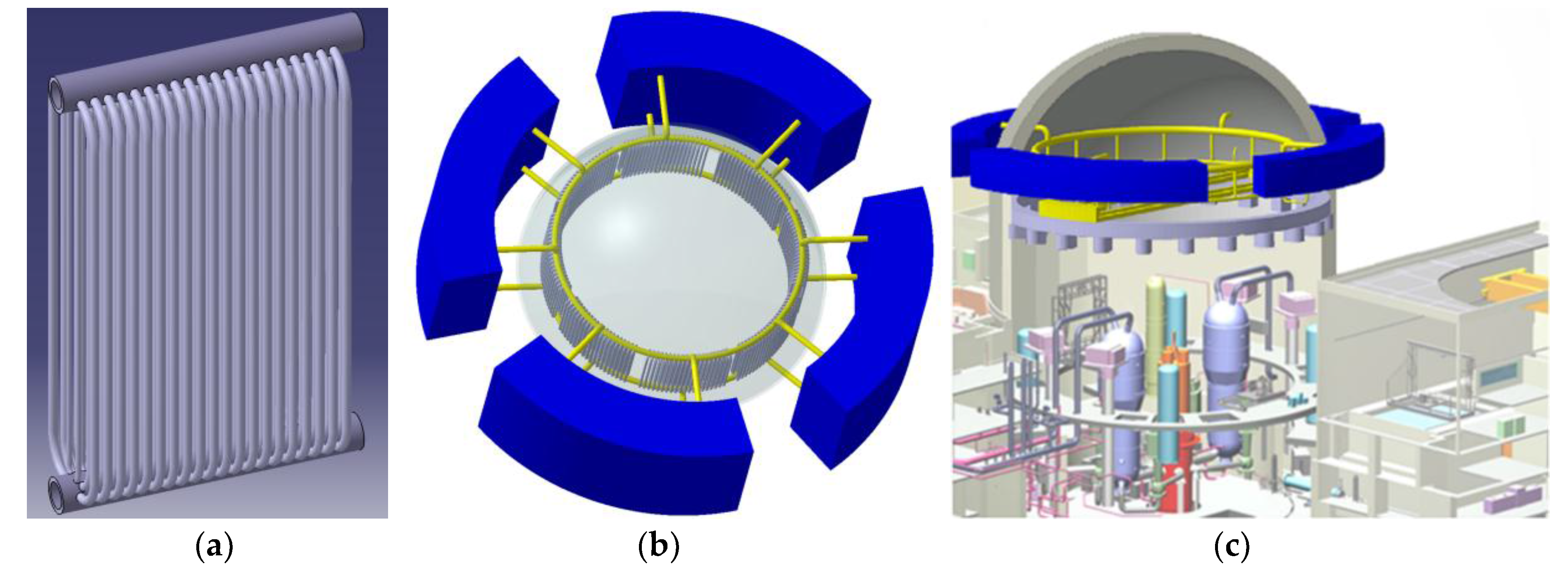
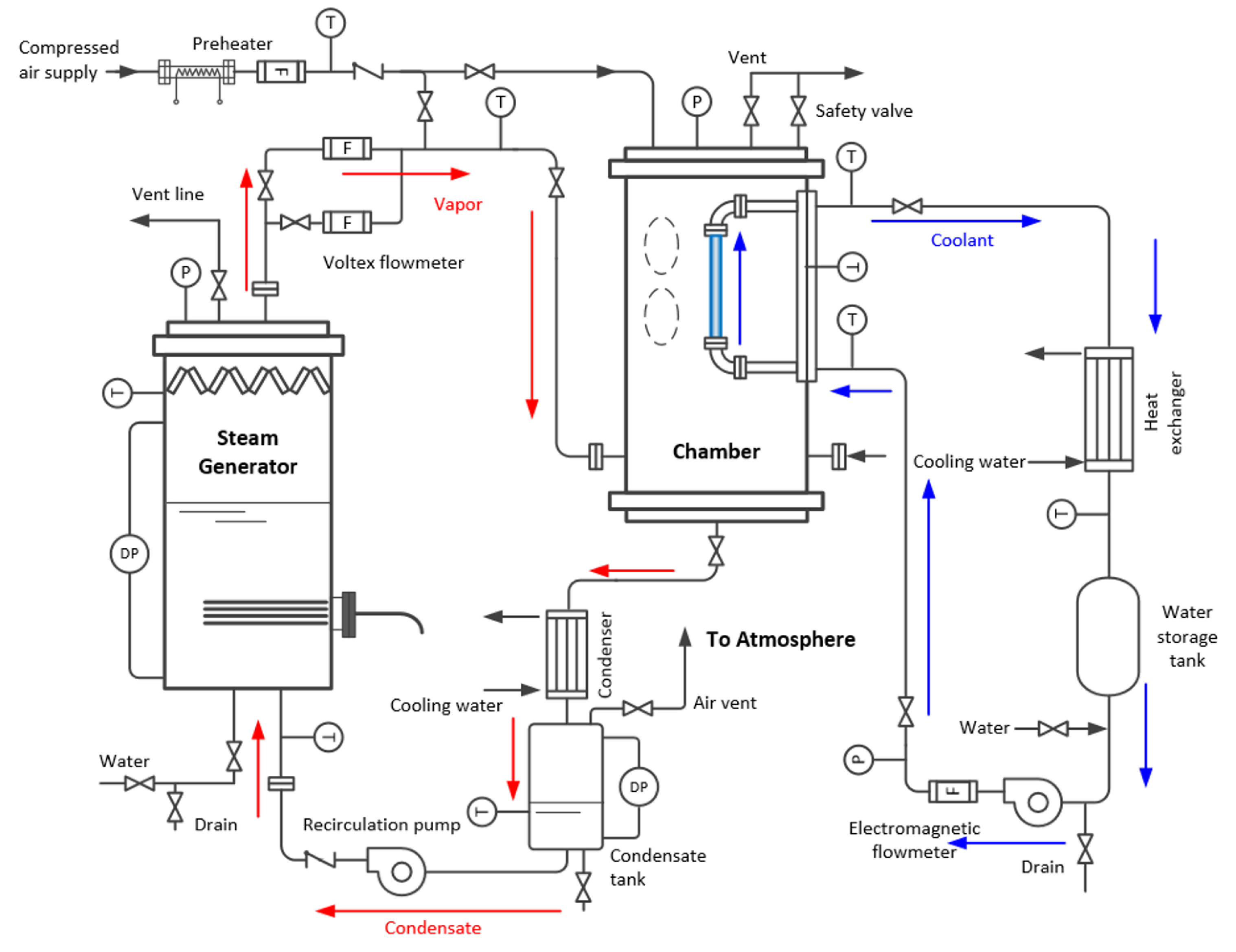
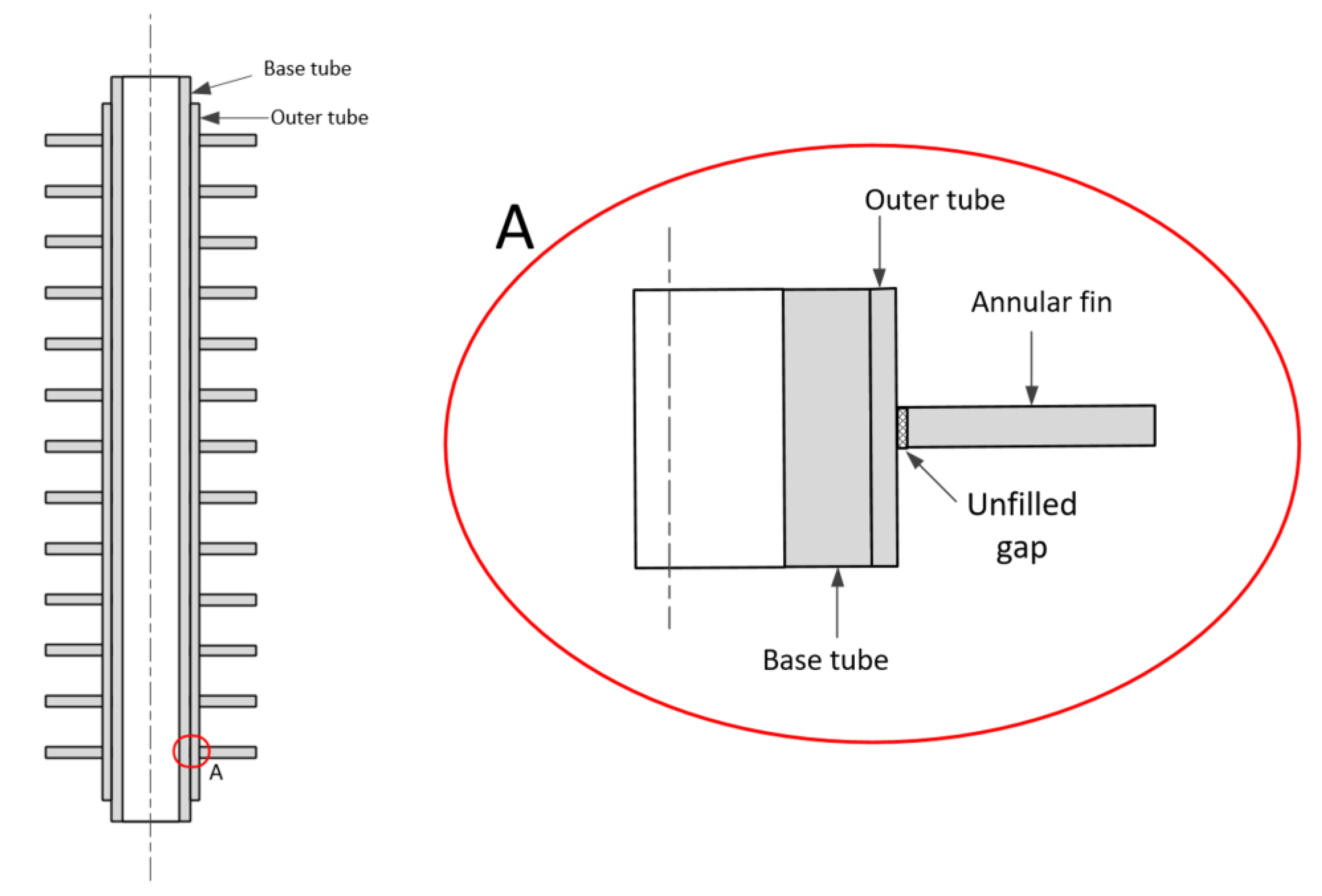
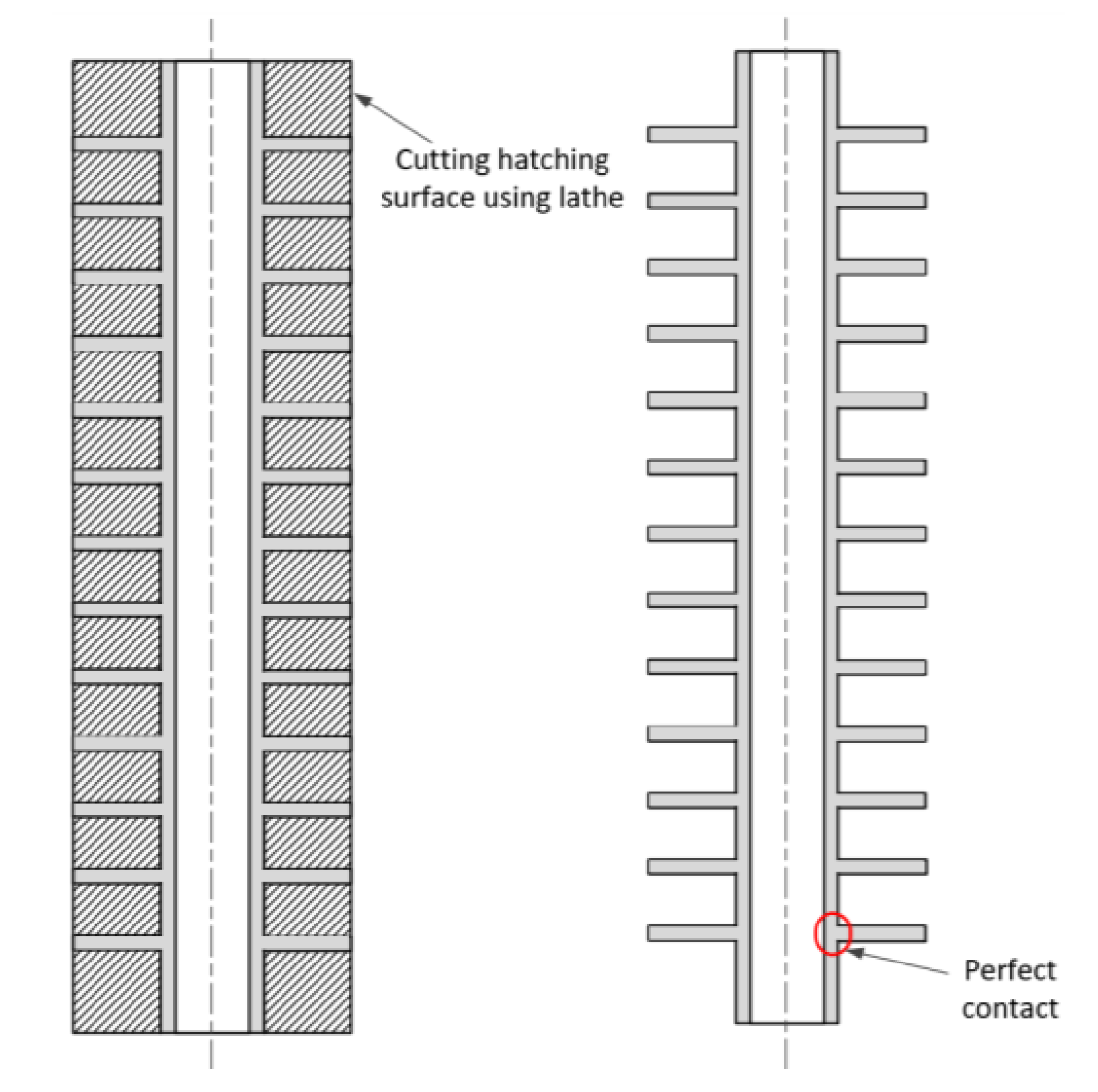


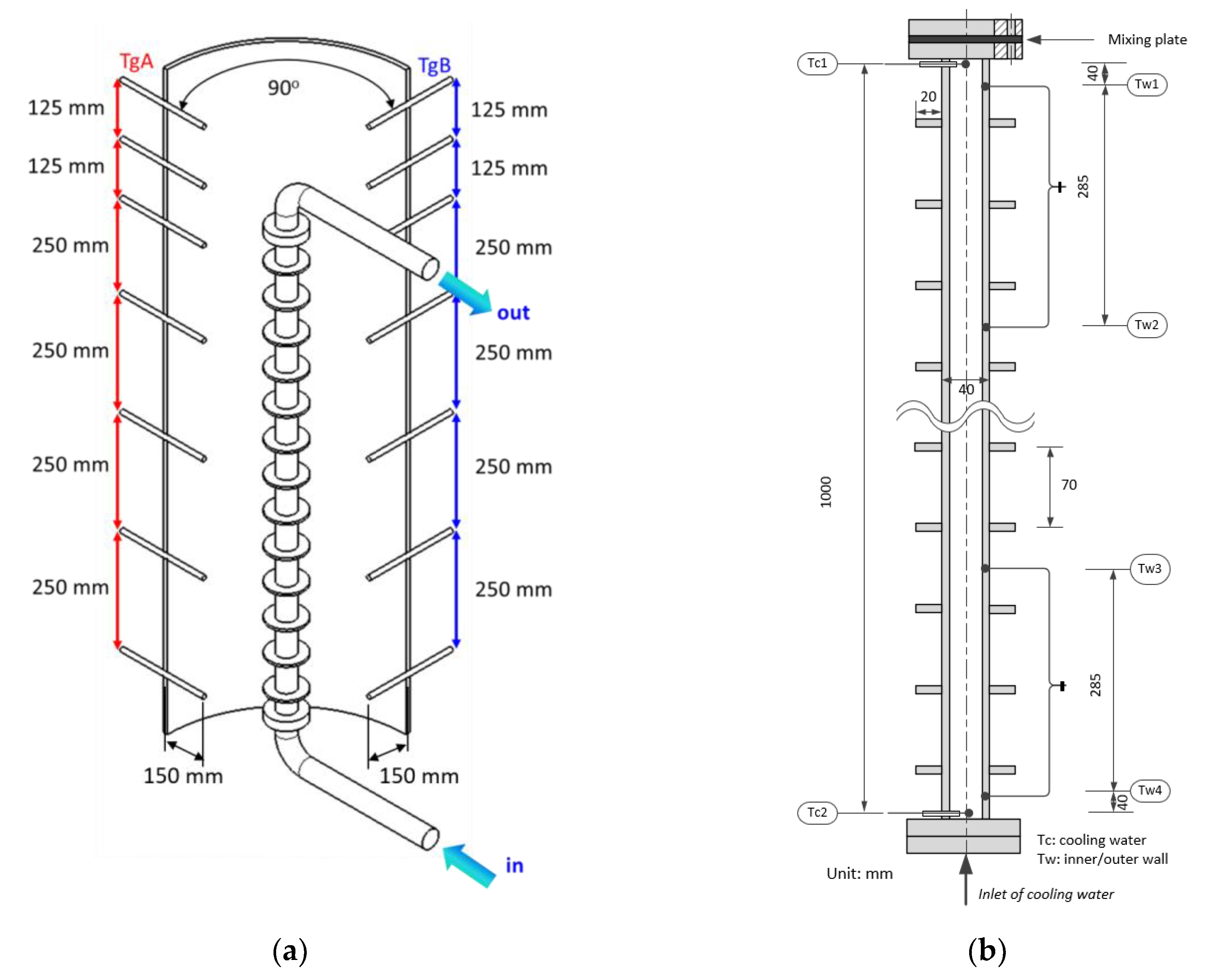
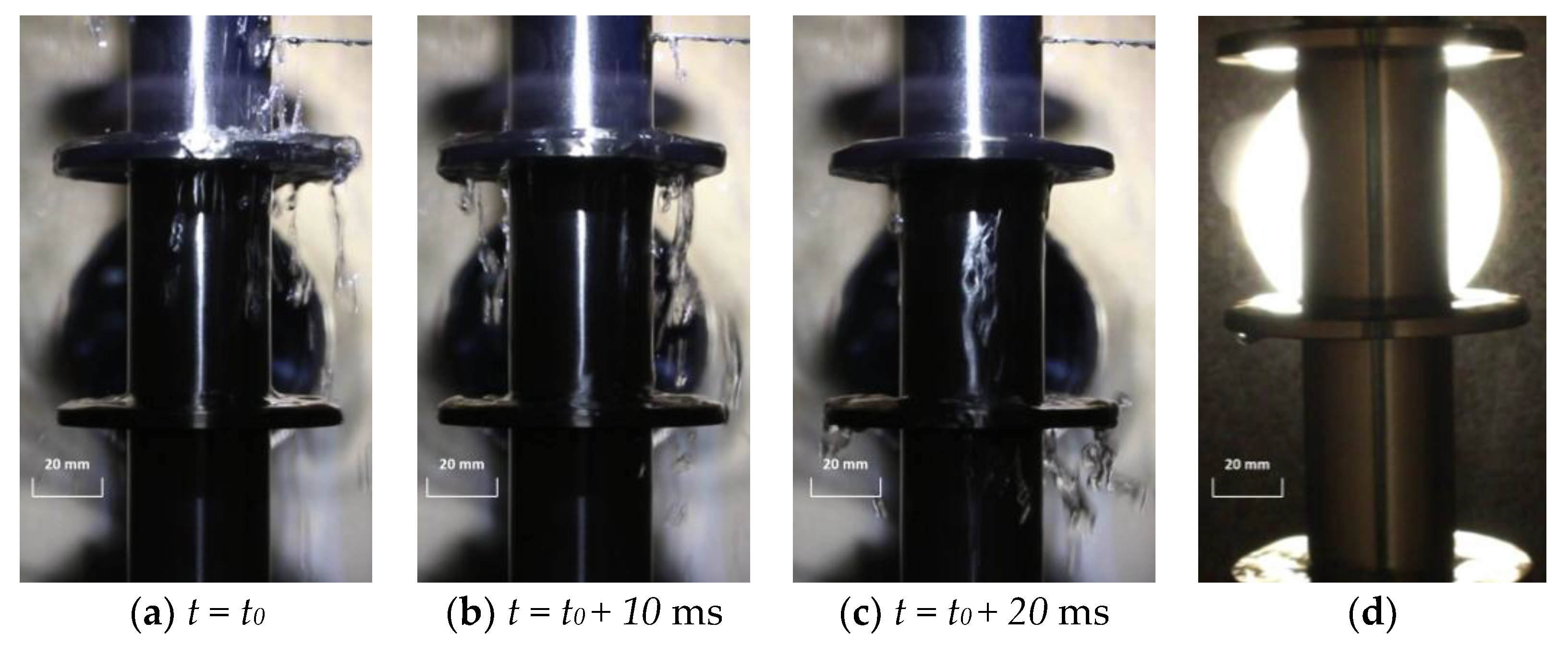
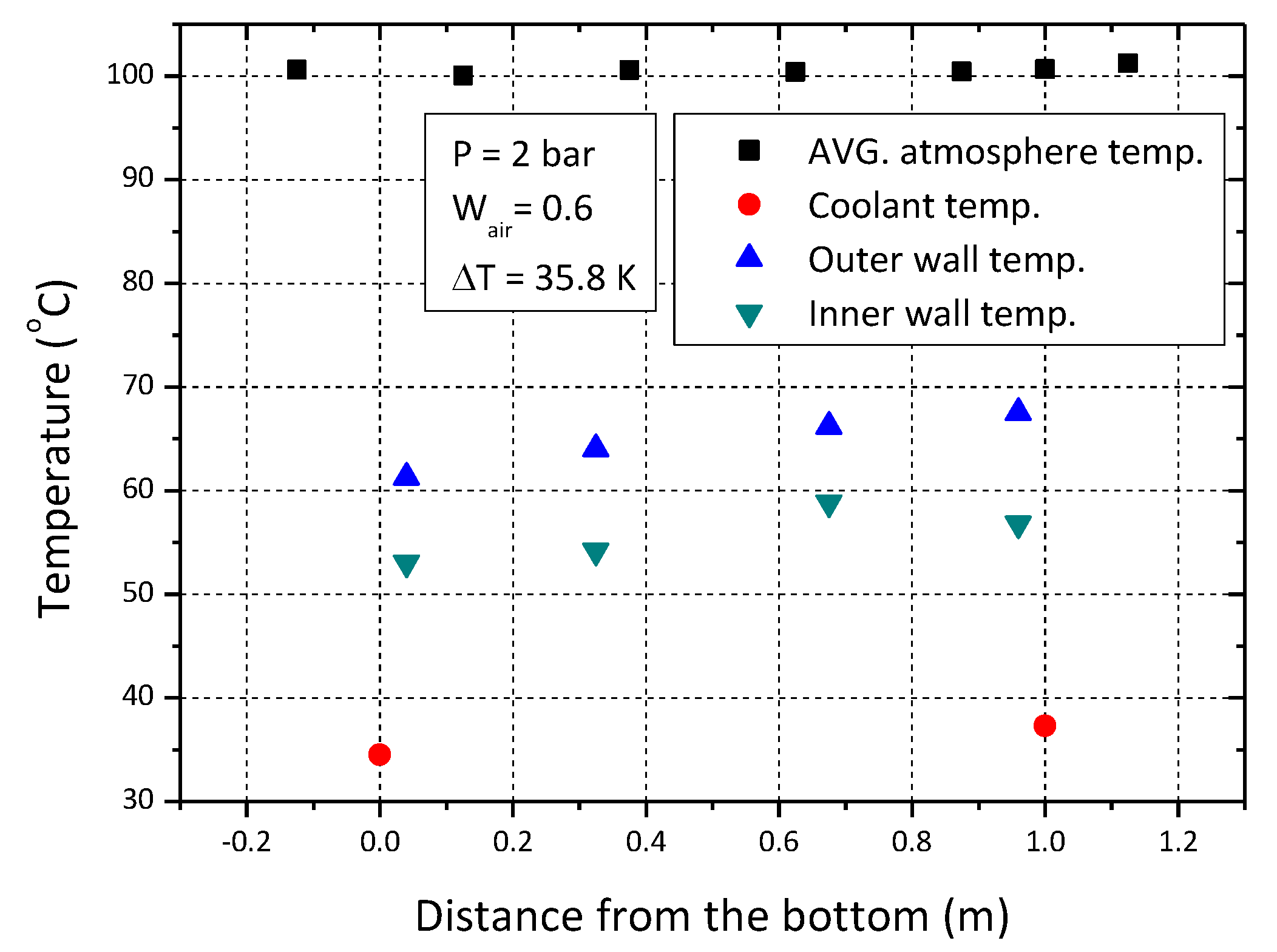
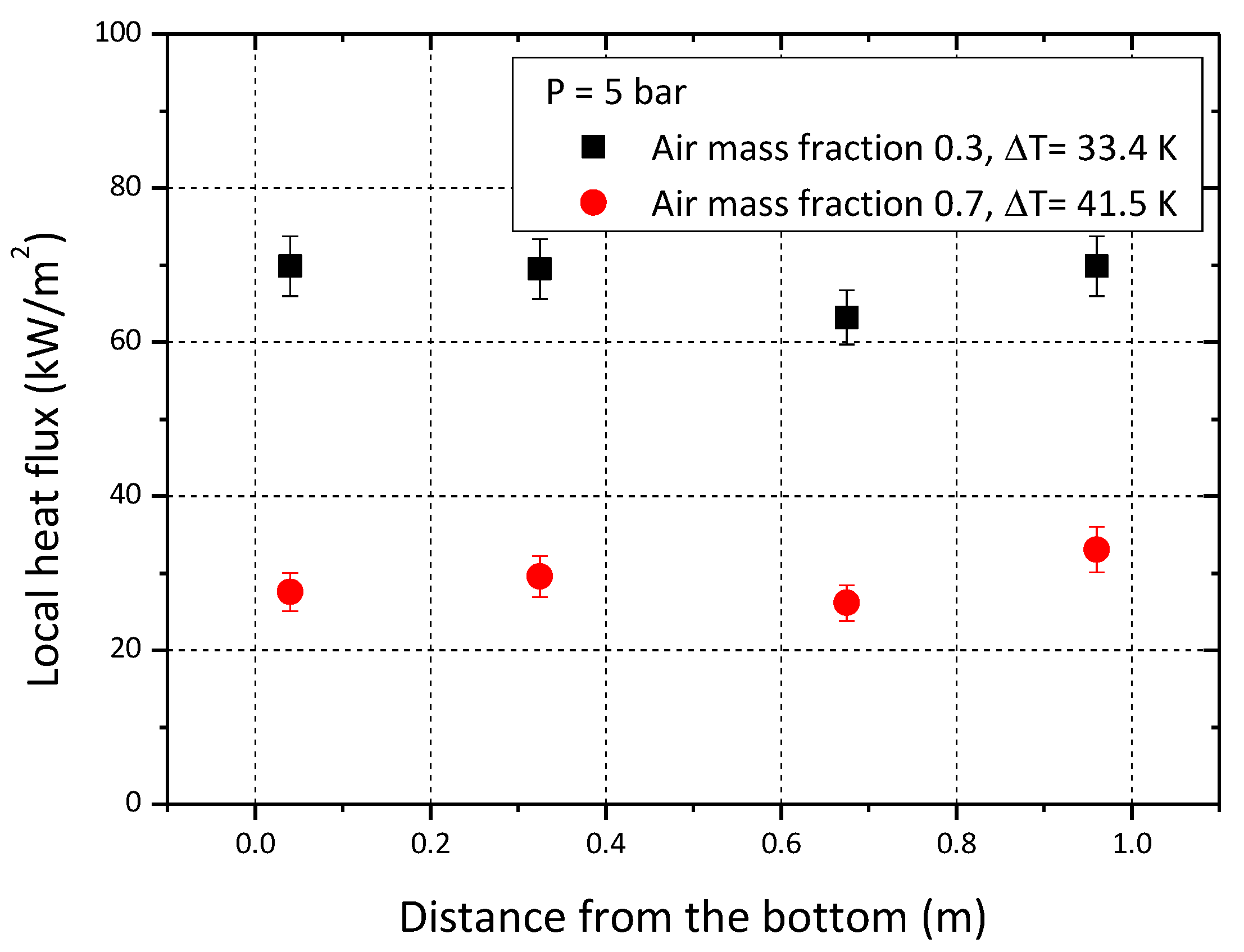
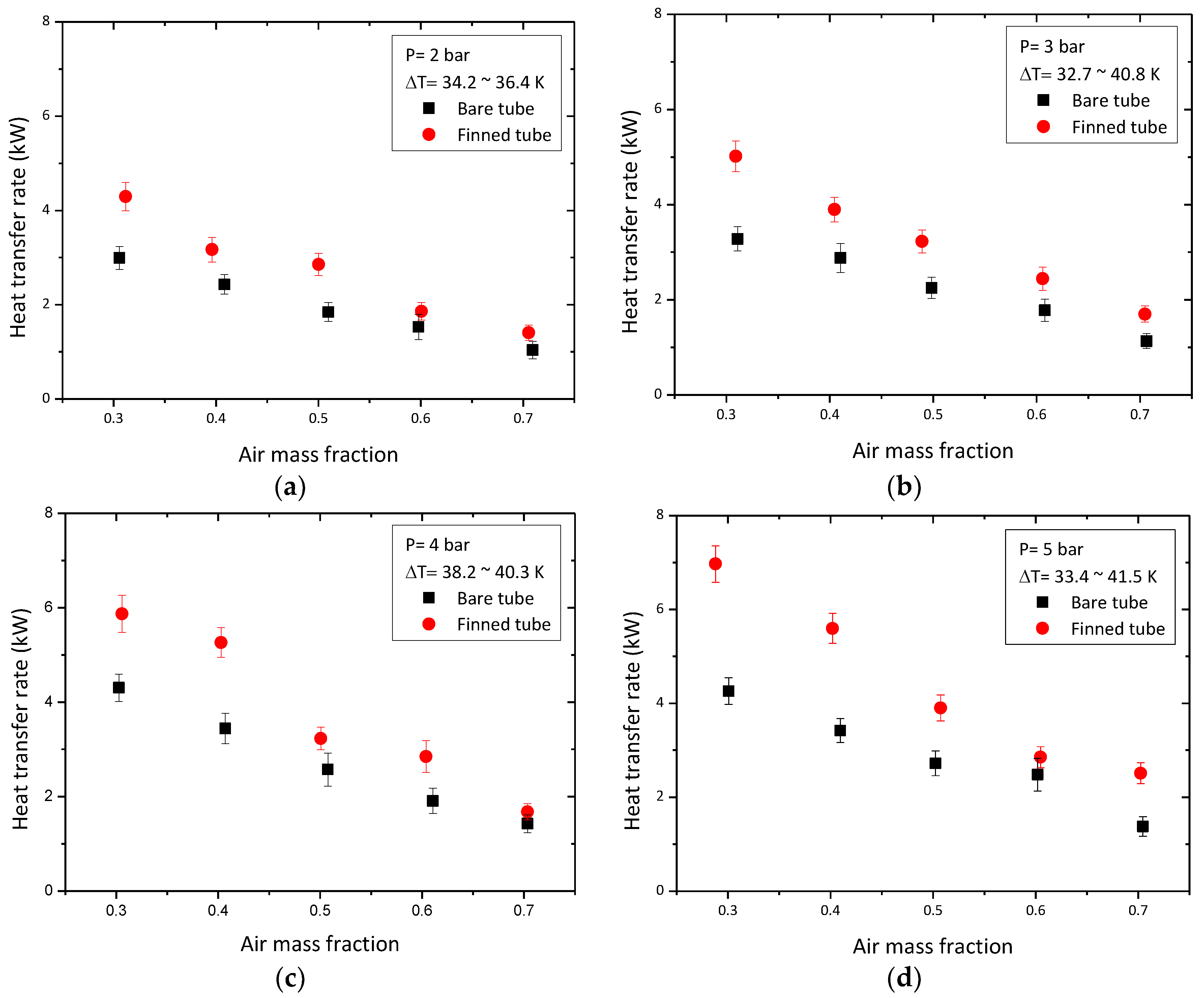

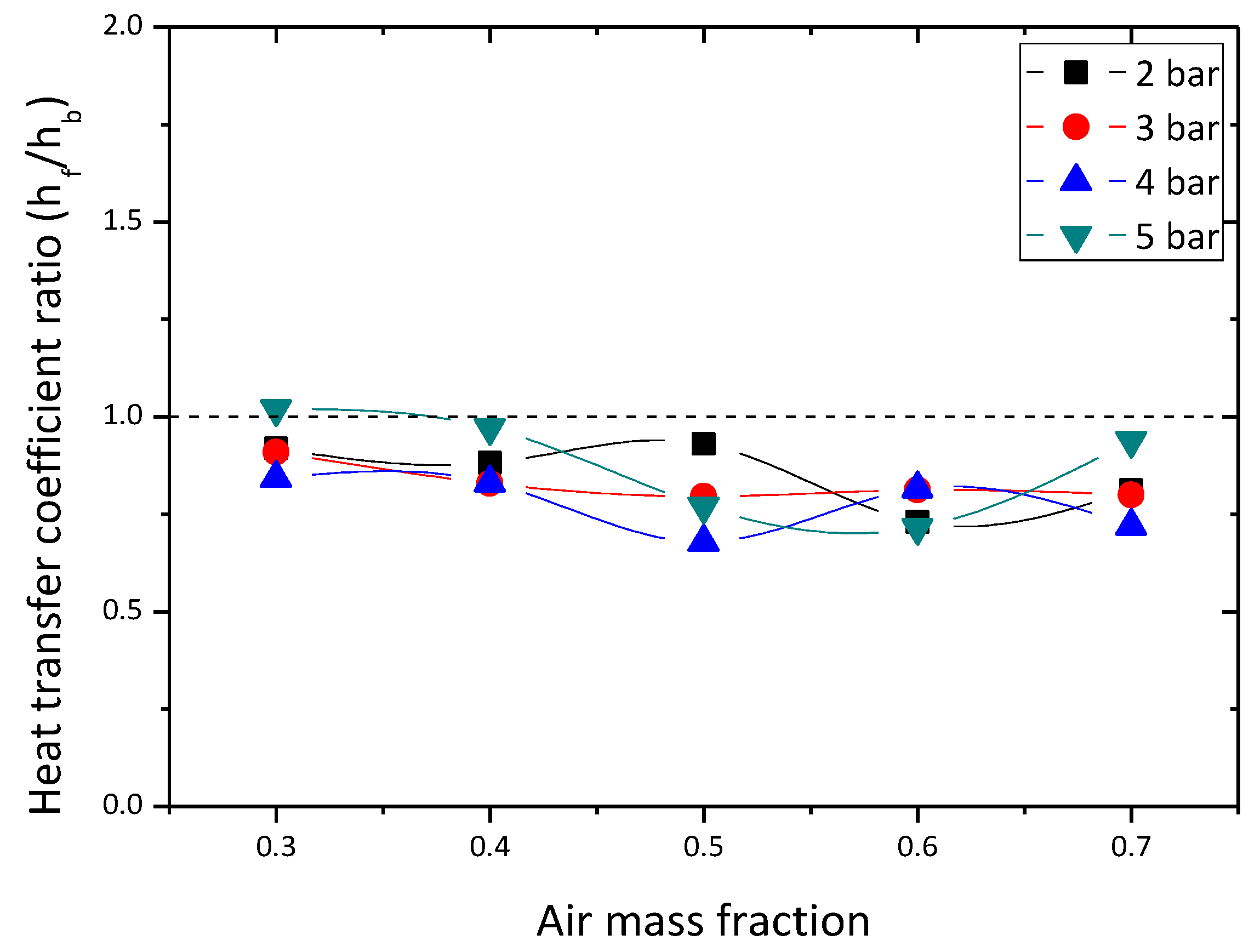
| Pressure (bar) | Air Mass Fraction (%) | Wall Subcooling (K) | Coolant Mass Flow Rate (kg/s) |
|---|---|---|---|
| 2 | 30~70 | 34.2~36.4 | 0.13~0.25 |
| 3 | 32.7~40.8 | 0.12~0.26 | |
| 4 | 38.2~40.3 | 0.12~0.35 | |
| 5 | 33.4~41.5 | 0.11~0.31 |
| Parameter | Measurement Instrument | Bias Error |
|---|---|---|
| Fluid temperature | Thermocouple (K-type) | 0.2 K |
| Wall temperature | Thermocouple (K-type) | 1.1 K |
| Coolant flow rate | Electrical flow meter | 0.1% of span |
| Chamber pressure | Pressure transmitter | 0.075% of span |
© 2017 by the authors. Licensee MDPI, Basel, Switzerland. This article is an open access article distributed under the terms and conditions of the Creative Commons Attribution (CC BY) license (http://creativecommons.org/licenses/by/4.0/).
Share and Cite
Jang, Y.-J.; Choi, D.-J.; Kim, S.; Hyun, M.-T.; Lee, Y.-G. Enhancement of Condensation Heat Transfer Rate of the Air-Steam Mixture on a Passive Condenser System Using Annular Fins. Energies 2017, 10, 1777. https://doi.org/10.3390/en10111777
Jang Y-J, Choi D-J, Kim S, Hyun M-T, Lee Y-G. Enhancement of Condensation Heat Transfer Rate of the Air-Steam Mixture on a Passive Condenser System Using Annular Fins. Energies. 2017; 10(11):1777. https://doi.org/10.3390/en10111777
Chicago/Turabian StyleJang, Yeong-Jun, Dong-Jae Choi, Sin Kim, Myung-Taek Hyun, and Yeon-Gun Lee. 2017. "Enhancement of Condensation Heat Transfer Rate of the Air-Steam Mixture on a Passive Condenser System Using Annular Fins" Energies 10, no. 11: 1777. https://doi.org/10.3390/en10111777





